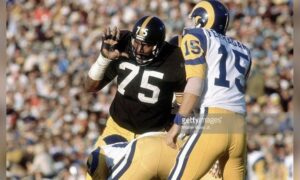When the Pittsburgh Steelers converted to the 3-4 defense in the early 80s, it was a move made in large part to reflect the shifting nature of the roster, following the retirement of Joe Greene and the depletion of the Steel Curtain.
But the shift in scheme, particularly in time, showed itself to possess valuable rewards, both on and off the field. Chief among them was the scarcity of the formation, which applied equally to roster building and to game planning.
At that time, nearly every team employed some form of the 4-3 defense, which is what opposing offensive coordinators had become used to in planning against. Going up a 3-4 defense as a novelty was as vexing to the coordinators, then, as it was to the offensive linemen who were unused to seeing it.
Equally as important is that the few teams who did run the 3-4 defense had less competition to collect the right talent to fit their scheme, which was largely the ‘tweener’ college defensive ends who were too small for the 4-3 at the professional level.
The Steelers used this as their bread and butter through the late 80s and the 90s, acquiring quality talent in the mid-to-late rounds such as Greg Lloyd, Jason Gildon, and Joey Porter. But the landscape has been changing since the 90s, and no doubt the Steelers’ own success in the 3-4 has played its part.
More and more teams are employing the 3-4 as their base defense, or incorporating key elements of it, to the point where around or nearly half the league can be said to be a 3-4 team. The consequences of this are obvious.
With more teams scouting and drafting the same type of player, the 3-4 pass rushing outside linebacker has become a greater and greater commodity, to the point where it’s now difficult to find a quality starter without red flags outside of the first round.
The Steelers have been finding this out for themselves, and are still waiting on Jarvis Jones to emerge after selecting him the first round of the 2013 NFL Draft. In the meantime, they are expected once again to turn to the outside linebacker position early in the draft, possibly with their first-round draft pick, their third year in a row on a linebacker.
Failing that, they figure to come away with at least one edge rusher, if not two, by the end of Friday as they compete with the other pressure-deficient 3-4 teams evaluating the same players the Steelers once had a seeming monopoly over.
On the field too, the 3-4 scheme is becoming less and less of an advantage as offenses continue to spread the field. The result is more defensive sub-package football, where the 3-4 is at a disadvantage without the appropriately hefty outside linebackers who can play end.
When a 3-4 team plays the nickel, it essentially becomes a 4-3 line with 3-4 ends as tackles and 3-4 outside linebackers as ends, creating a smaller front. With the 3-4’s inability to generate four-man pressure more consistently without elite personnel, the Steelers have found that they no longer have the advantages that they once exploited.








